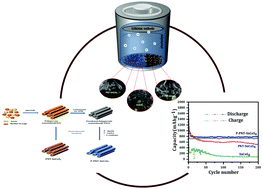New rationally designed hybrid polypyrrole@SnCoS4 as an efficient anode for lithium-ion batteries†
Abstract
In the current study, the impact of two different substrates was investigated on the improvement in capacities. SnCoS4 nanoparticles were coated on polypyrrole nanotubes (PNT) and pyrolyzed polypyrrole nanotubes (P-PNT) using the facile hydrothermal method. Both anode materials were electrochemically compared to pure nanoparticles in the lithium-ion half-cell. The results of electrochemical analysis introduced the P-PNT–SnCoS4 as an optimum structure with a reversible capacity of 784 mA h g−1 at a current density of 0.2 A g−1 after 200 cycles. This finely-crystallized nanoparticle supported by carbonaceous polypyrrole nanotubes still maintained its capacity (424 mA h g−1) at a higher current density of 4 A g−1, which shows the efficient synergistic contribution of the substrate to buffering the volume changes in Sn-based anodes. We can conclude that binary metal sulfides supported by 3D polymer-based substrates have great potential for application as promising anode materials in future lithium-ion batteries (LIBs).



 Please wait while we load your content...
Please wait while we load your content...